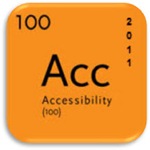 A month prior to presenting at South by Southwest (SXSW) in Austin, I dutifully requested an accessible route up to the stage, if, indeed, there was a stage. The conference organizers assured me that the stage would be accessible.
A month prior to presenting at South by Southwest (SXSW) in Austin, I dutifully requested an accessible route up to the stage, if, indeed, there was a stage. The conference organizers assured me that the stage would be accessible.
Awesome. One less detail to worry about.
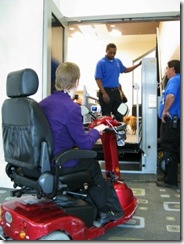
(Photo credit: Sheila Scarborough)
Minutes before I was due to begin my presentation, Austin Convention Center staff wheeled in a monstrous wheelchair lift. After plugging it in and fiddling with it for several minutes, the guys decided that it might work better on the other side of the stage.
The lift was moved to the other side and fiddled with for several more minutes. Meanwhile the audience was becoming understandably restless. With so many sessions to choose from, attendees do not stay in sessions that do not capture their attention. I envisioned everyone leaving before I could get on the stage.
For some unexplainable reason the lift did not work any better on the other side and was brought back to the first side. This time the lift did go up but not down. Because I have yet to master jumping several feet with my scooter, I needed the lift to go down before going up. Obviously that was not going to happen any time soon.
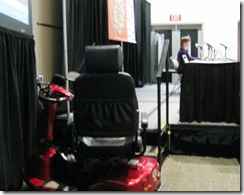
(Photo credit: Sheila Scarborough)
Time for Plan B.
With only three stairs up to the stage, I suggested that, with assistance, I could walk up onto stage. Both Becky McCray and Paul Merrill kindly offered their assistance.
On my way over to the other side of the stage, Becky offered Plan C: move the computer down so that I didn’t need to go up on stage. I considered her suggestion very briefly: Damn it, I had worked my butt off getting my presentation ready a getting to Austin. I was going to present from that stage – like everyone else.

(Photo credit: Paul Merrill)
The three of us made our way up the stairs and over to the waiting chair. Thankfully everyone had waited; they were engaged in the live accessibility lesson unfolding before them.
I began my presentation, many minutes late. With Becky’s, Sheila’s and Paul’s assistance during the hands-on rubber band demonstration, the session rocked despite the rocky start!
To the Austin Convention Center and other conference facilities, I offer these recommendations:
- Keep lift equipment in good operating condition.
- Test the equipment prior to when it is needed.
- Train facilities staff in how to use the equipment. Offer refresher training as needed;say,before an event where the equipment is needed.
- Keep a portable ramp on hand in the event of mechanical failure. A less than ideal way to get on stage is
- better than no way at all.
I was able, with assistance, to get up on stage and to proceed with my presentation. Another presenter may not be able to do the same and the presentation (and all associated costs) would be lost.
Accessibility 100 is a series of 100 easy-to-implement, free and inexpensive tips for improving accessibility for people with disabilities. This is a community project. Feel free to leave your comments, questions and ideas for future Accessibility 100 posts.
Get the entire series by subscribing to the blog posts via email or by subscribing to the RSS feed.
If you enjoyed this post, consider buying me a chai tea latte. Thanks kindly.
 Earlier today I read, on a major blog, an article about what never to say to people in wheelchairs. However, I will not dignify it with a link.
Earlier today I read, on a major blog, an article about what never to say to people in wheelchairs. However, I will not dignify it with a link.
 Today being another glorious summer day, Darrell and I did our favourite road trip in reverse for a change. Taking the Skytrain into downtown Vancouver to Waterfront Station. We enjoyed the easy-to-manoeuvre seawall path around Coal Harbour, a spot I love.
Today being another glorious summer day, Darrell and I did our favourite road trip in reverse for a change. Taking the Skytrain into downtown Vancouver to Waterfront Station. We enjoyed the easy-to-manoeuvre seawall path around Coal Harbour, a spot I love.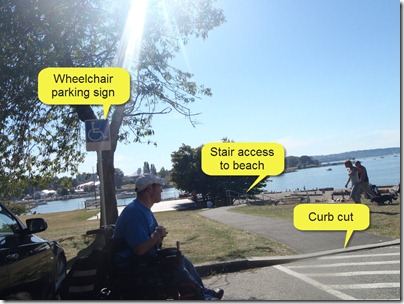
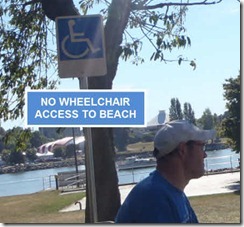
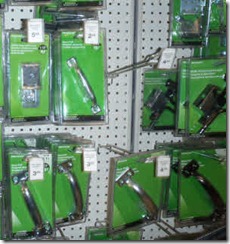 The solution?
The solution?


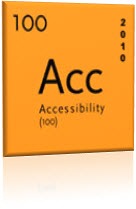 Last weekend Darrell and I checked out a brand new recreation centre in our extended neighbourhood. Me being who I am, I was noticing the accessibility features: the automatic sliding front doors, the automatic door opener for the wheelchair accessible washroom, the flashing fire alarm, the Braille on the elevator keypad and on the room signs, the wheelchair parking stalls near the front door and the like.
Last weekend Darrell and I checked out a brand new recreation centre in our extended neighbourhood. Me being who I am, I was noticing the accessibility features: the automatic sliding front doors, the automatic door opener for the wheelchair accessible washroom, the flashing fire alarm, the Braille on the elevator keypad and on the room signs, the wheelchair parking stalls near the front door and the like. 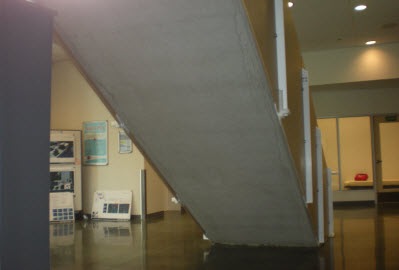
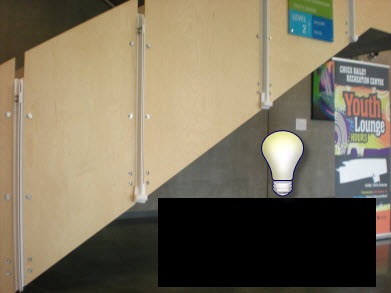
 Subscribe via RSS
Subscribe via RSS



